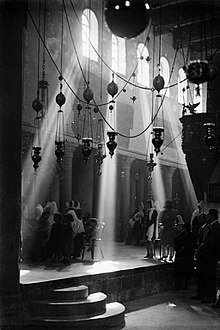Our website is made possible by displaying online advertisements to our visitors.
Please consider supporting us by disabling your ad blocker.
Church of the Nativity
| Church of the Nativity | |
|---|---|
 The interior of the Church of the Nativity circa 1936, photographed by Lewis Larsson | |
| Religion | |
| Affiliation | Shared: Greek Orthodox Church, Armenian Apostolic Church, and Roman Catholic Church with minor Coptic Orthodox and Syriac Orthodox rights |
| Status | Active |
| Location | |
| Location | Bethlehem, West Bank |
| Geographic coordinates | 31°42′15.50″N 35°12′27.50″E / 31.7043056°N 35.2076389°E |
| Architecture | |
| Architectural type | Byzantine (Constantine the Great and Justinian I) |
| Architectural style | Romanesque |
| Groundbreaking | 325 |
| Completed | 565 |
| Official name: Birthplace of Jesus: the Church of the Nativity and the Pilgrimage Route, Bethlehem | |
| Type | Cultural Heritage |
| Criteria | iv, vi |
| Designated | 2012[1] |
| Reference no. | 1433 |
| State Party | State of Palestine |
| Region | Western Asia |
| Part of a series on |
| Palestinians |
|---|
 |
| Demographics |
| Politics |
|
| Religion / religious sites |
| Culture |
| List of Palestinians |
The Church of the Nativity is a church in Bethlehem. It is one of the oldest churches in the world. It is built over the cave that tradition marks as the birthplace of Jesus. It is considered very sacred to Christians and Muslims.
The main basilica is maintained by the Greek Orthodox Patriarch of Jerusalem. Underneath the building is a cave or grotto. It is where Jesus is said to have been born. On Christmas Eve, crowds gather to sing Christmas carols outside the church in an area called Manger Square. The crowds also go to celebrate midnight mass at the Church of Saint Catherine, a Roman Catholic church next door to the basilica. It is performed by the Latin Patriarch of Jerusalem.
The basilica has been reported to be not very well preserved.[2][3] The Palestinian government started restoring the buildings in 2010.[4] It was made a World Heritage Site by UNESCO in June 2012. It is the first World Heritage Site listed under Palestine. It was listed as being in danger.[5]
- ↑ "Unesco, Birthplace of Jesus: the Church of the Nativity and the Pilgrimage Route, Bethlehem". UNESCO World Heritage Centre. Retrieved 1 July 2012.
- ↑ "CHURCH OF THE HOLY NATIVITY | World Monuments Fund". Wmf.org. Retrieved 2011-12-22.
- ↑ Kumar, Anugrah (28 November 2011). "Bethlehem's Nativity Church to Get Overdue Repairs". The Christian Post.
- ↑ "Topic Galleries". chicagotribune.com. Retrieved 2011-12-22.[permanent dead link]
- ↑ Lazaroff, Tovah (June 29, 2012). "UNESCO: Nativity Church heritage site in 'Palestine'". The Jerusalem Post. Retrieved 2012-06-29.
Previous Page Next Page


